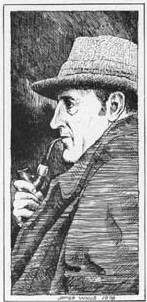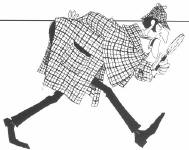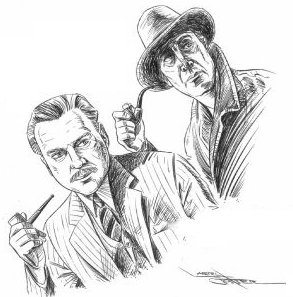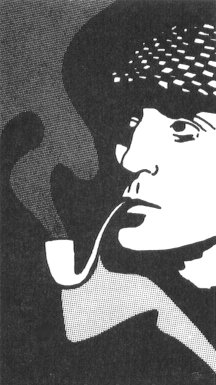|
Leaving Baker Street
He moved from his Bellagio Road home in Bel-Air in June of 1946 to New York in a return to the stage. The following year he starred in “The Heiress” on Broadway, where he was a critical success. His motion picture work though dropped off sharply and immediately. When “The Heiress” was turned into a film in 1949 the part he’d played on stage went to Ralph Richardson. Where once Rathbone had landed a leading or supporting role in as many as five or six features a year from the silent era through the war years, after 1946, he only turned in a film every couple of years. His career eventually moved from Broadway to slap-dash television parts and to cinematic plonk like “Ghost in the Invisible Bikini.” As early as 1958 he complained in a letter to actor David Macklin of having not much on the horizon. His last film, in 1967, was a Mexican horror cheapie called “Autopsy of a Ghost,” which is almost impossible to find today. He died of a heart attack in July of that year. Rathbone’s 1962 autobiography, “In and Out of Character,” is
significantly quiet on his Sherlock Holmes career, which he covers in a
chapter of 11 tight-lipped pages. What he does say about his decision to
quit, he puts succinctly: He mentions that at the time of his departure, MCA, the agency which represented him, was drawing up a contract to keep Rathbone and Nigel Bruce on the radio series for another seven years. Meanwhile, Universal owned the rights to the Holmes character for another three years. But Rathbone was finished; his contract was up. He’d grown tired of handing in, as he called them, “carbon copies” of his Holmes interpretation. In his excellent book, “Basil Rathbone: His Life and His Films,” Michael Druxman reports a story told by Rathbone’s wife, Ouida, that captures the actor’s frustration with the Holmes role. A group of children was following the actor on the street one day, calling out for an autograph — calling out the name “Sherlock Holmes.” Rathbone whirled around and demanded that they say his real name. “Sherlock Holmes,” came the reply. He refused to give them an autograph until they could produce his real name — which they could not do. A look at Rathbone’s filmography tells its own story. In 1939 when he made “The Hound of the Baskervilles” and “The Adventures of Sherlock Holmes” for Fox, Rathbone was also featured in four other films —these include a delightfully mordant turn as Richard III in “Tower of London” and the Baron in the wonderfully arch “Son of Frankenstein.” In 1941 he made four films, none of them Holmesian. In 1942, a new pattern begins to emerge; he made “Sherlock Holmes and the Voice of Terror,” “Sherlock Holmes and the Secret Weapon,” and just two other non-Holmes films. Each year the trend continued. By 1945 he made just three pictures — all Holmes. And in 1946 there were two Holmes films and one dreary comedy, a Ginger Rogers vehicle called “Heartbeat.” It doesn’t take stellar deduction to conclude that the parts were no longer rolling in. The Holmes series is comprised of 16 films; each is about an hour in length. The first two were filmed at Fox. The remainder were produced at Universal. According to Universal archives, each film only required about an 18-day shoot and for that service, Basil Rathbone received a flat fee of $20,000. In 1946, that was serious money. A can of pork and beans cost nine cents in Los Angeles at the time. A nightclub dinner ran $1.75 and rent on a three-bedroom house in a good neighborhood was in the area of $300 a month. More to the point, day players on the Holmes films got $250 a week, a script clerk $160, and a cameraman received $350. A talent such as Henry Danielle got $4,500 for his memorable Professor Moriarty in “The Woman in Green.” Accounting for inflation, Rathbone’s $20,000 equals about $180,000 in current monetary value. Universal was filming three Holmes films a year on average. So in today’s market, Rathbone was making more than $500,000 a year for about 54 working days. David Niven called Basil Rathbone the highest paid freelancer of the era. When factoring in the Holmes radio work — he and Nigel Bruce did more than 200 weekly shows— Rathbone’s yearly Holmes income probably approached $800,000 or so (still dealing in today’s dollar). Factor in his other film, radio and advertising work and he may have closed in on $1 million. From this he walked.
Rathbone writes about the fall-out with his co-star, “…for a while my long-time friendship with Nigel Bruce suffered severe and recurring shocks.” Bruce made only eight more generally forgettable films between the end of the Holmes series and his death in October 1953. While Rathbone confines his reasons for leaving to his boredom and bitterness with the role, he may have recognized other reasons the series as a whole had outlasted its natural life. Many who love the Holmes movies certainly see a dampening of vitality in the later pictures. “Dressed to Kill,” while it has a terrific title, fails in many ways to capture the qualities of earlier productions. After more than a dozen stints as director-producer, Roy William Neil had gathered around him a group of writers, actors and technicians who by all accounts were a happy family. The director was known affectionately as “Mousie” by his crew and players. The studio was certainly happy with receipts. Each film was budgeted at an affordable $220,000 to $240,000, they came in on time and without significant cost overruns. And they made money. But guaranteed income and contentment are rarely a formula for excellent filmmaking. A winding-down is evident in more than just aesthetics. For one thing, the friction with the censors at Hays Office had slacked off, a possible sign of loss of “juice” on the part of the writers. The censors practically rubber stamped the scripts of the films of 1946. Small adjustments were called for here and there. Films earlier in the series, however, were not received so gladly by the censors. In 1944, for example, an early script of the film “Invitation to Death” (released as “The Woman in Green”) was declared “in violation of the code.” The letter to Universal, signed by Joseph Breen, suggests the script had a certain grisly vitality. The letter reads: “The basic objection to the present story is the fact that little eight and nine-year old girls are murdered and their bodies are mutilated by the severance of a finger …” The Hays office believed such a film would “lower the moral sensibilities of persons witnessing such a performance.” The letter goes on at length to spell out problems with improper language, drug references and violence. All of these indicate, at least to the modern mind, suggest a challenging creative vigor in the earlier films that had fallen away later. Even 1943’s, “Sherlock Holmes in Washington,” shows some energy in its production, with William Neil choosing to shoot scenes in Washington D.C. at the height of the war rather than rely on stock footage. The director had to work his way through numerous layers of studio and War Department authority, butting up against the redoubtable Office of Censorship, to get permission to film shots of National Airport and other scenes of the nation’s Capitol that were key to the success of the picture. Inertia is perhaps also evident in the decelerating pace of filming
itself. According to the assistant director’s daily reports, “Terror by
Night” in 1946 averaged 8.5 scenes shot per day; “Dressed to Kill” later
that same year averaged just 6.2. Compare that with “Woman in Green” just
a year earlier. That film averaged 11.5 scenes shot per day while “House
of Fear,” also shot in 1945, averaged nearly 14. While speed of filmmaking
in not necessarily a measure of quality — Ed Wood’s “Plan 9 From Outer
Space” comes to mind —it may hint at a general relaxation that was falling
over the company. Did Rathbone regret his decision to leave? Not at first. When he finally and convincingly announced he would not return to the series he writes of his state of mind, “Supremely confident and relaxed, sipping a gin and tonic, I lounged in a comfortable chair in my room at the Ritz Hotel ...” Eventually, he must have missed something about the role, perhaps the income. In 1953 he reprised the role of Holmes on stage in a play written by his wife. In this way, one can imagine, he might have thought to cash in on the Holmes recognizability within the context of the theater, which he felt more suited his abilities. But the play bombed. In “In and Out of Character” he writes that the dress rehearsal was a disaster and in the first scene of the first performance he “blew up” and never quite recovered, turning in a dreary, mechanical performance. One review mentions missed lighting cues and other glitches. Rathbone continued to don the deerstalker from time to time in TV appearances such as the Milton Berle show. One wonders if it was really thinkable to walk away from the role of the Baker Street detective unscathed careerwise. After 16 films? After 200 weekly radio shows? After numerous print ads for cigarettes and other products posing as Holmes? The urge to separate himself from the role is understandable, but at some moment in that 1939 to 1946 timeline there was a point of no return. That he did leave was courageous and probably prompted by impulses of a reasonably pure artistic nature. But Rathbone’s story is not so much of an actor who walked away from a bank vault of money, but of an actor who walked away too late. In a letter to Newsweek magazine in June 1956 Rathbone wrote that Hollywood had started him off in light comedy, then condemned him to villain roles and had “buried” him as Holmes. He wrote: “I have enjoyed a very versatile career, with only Sherlock Holmes as a seemingly perpetual stumbling block. How deeply I sympathize with Sir Arthur Conan Doyle who tried so hard to kill Holmes at the Reichenbach Falls!” While this sounds like the hollow cry of victim-think, it is probably the case that there was little he could do throughout most of the ‘40s to rescue himself from typecasting. Once he signed the contract and embarked on the films, his image as Sherlock Holmes was forever fixed in the public imagination. Phrases like “Elementary, my dear Watson,” and “Quick Watson, the needle,” entered the general lexicon. Thanks to the power of mass media Rathbone became an actor who lost ownership of his own face, voice and persona. He became a brand. Like Lugosi with Dracula, Karloff with Frankenstein and actors such as Marilyn Monroe, Groucho Marx, John Wayne and others who exist in the popular consciousness not so much as humans but as ideas, images. This transformative power of media must not have been lost on Rathbone when he signed the contract he came to detest. What he had hoped to walk away from, ultimately, was this transformation. He hoped to reverse it, erase it. Yet the icon status would remain attached to Rathbone like his own shadow in a glare of stagelights.
|







 A
piece of take-this-job-and-shove-it lore that has long fascinated fans of
Hollywood’s belle epoch is the story of Basil Rathbone walking away from
his lucrative role as Sherlock Holmes. Easily screenland’s most famous
Baker Street sleuth, the classically-trained actor grew weary and
embittered playing the part that made him famous from Borneo to the Santa
Monica Pier. He came to deeply regret signing a long-term contract that
kept him playing the role in film after film. And in spite of what must
have been great pressures to the contrary, he turned his back on not only
the Holmes series but arguably on his film career as well.
A
piece of take-this-job-and-shove-it lore that has long fascinated fans of
Hollywood’s belle epoch is the story of Basil Rathbone walking away from
his lucrative role as Sherlock Holmes. Easily screenland’s most famous
Baker Street sleuth, the classically-trained actor grew weary and
embittered playing the part that made him famous from Borneo to the Santa
Monica Pier. He came to deeply regret signing a long-term contract that
kept him playing the role in film after film. And in spite of what must
have been great pressures to the contrary, he turned his back on not only
the Holmes series but arguably on his film career as well. 
 His
decision was a sharp blow to his friendship with Nigel Bruce. And it’s no
wonder when you look at the numbers. Bruce was under contract to Universal
(Rathbone was on loan from MGM throughout the series). As Dr. Watson,
Bruce started the series making $5,000 per picture. By 1946 his salary had
tripled, up to $15,000 per film.
His
decision was a sharp blow to his friendship with Nigel Bruce. And it’s no
wonder when you look at the numbers. Bruce was under contract to Universal
(Rathbone was on loan from MGM throughout the series). As Dr. Watson,
Bruce started the series making $5,000 per picture. By 1946 his salary had
tripled, up to $15,000 per film. 